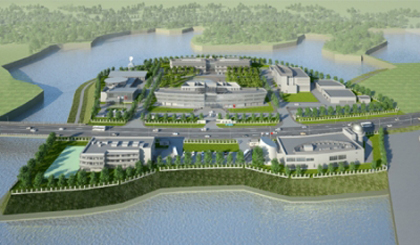Door opens for Vietnam's aerospace technology development
Vietnam has set up an ambitious aerospace development programme with construction of the 9ha Vietnam Aerospace Centre (VAC) at Hanoi-based Hoa Lac Hi-tech Park to be kicked off by early of 2015.
Five years later, another made-in-Vietnam satellite - LOTUSat 2 - is expected to be launch into orbit.
With all the above, Vietnam has grounded one of the leading modern aerospace research, implementation and training centres in Southeast Asia.
 |
| Perspective of the Vietnam Aerospace Centre at Hanoi-based Hoa Lac Hi-tech Park |
A turning point in investment
Experts said that Vietnam has learned from countries with developed aerospace technology to choose its own suitable direction for the national aerospace development. It resulted from the Party and State’s decision to invest in the key project for the VAC establishment, aiming to fulfil the national aerospace development strategy towards 2020. The scheme also targets promoting international co-operation for infrastructure and human resource development in the field as well as building an aerospace development roadmap compatible with Vietnam’s current conditions.
Each year Vietnam spends 2% of its total expenditure for scientific and technological development activities, of which 10% is for national scale research and deployment worth approximately US$100 million. Meanwhile, the VAC project costs nearly JPY54 billion (US$600 million), sourced from Japanese ODA and Vietnamese counterpart funding. This affirms the Vietnamese Government’s determination in increasing investment (equivalent to six year investment for national scale scientific and technological research and deployment) in aerospace development to reach the regional level by 2020.
Co-operation and training important to aerospace development
As a high-tech industry, international co-operation plays an important role in aerospace sector development. In recent years, the VAC has participated in several projects, including Japanese Quasi-Zenith Satellites System, Japan-ASEAN earth-observation satellite system, and US NASA GLOBE programme. At the same time, the centre is seeking further collaboration with international aerospace centres.
Targeting high quality human resource development, the centre will send its 54 staff on training courses abroad on satellite technological transfer, of which 36 will be trained in five leading institutes with advanced aerospace technology in Japan. They will take part in a programme on designing, assembling and launching a 50kg micro satellite.
Regarding suitable development for Vietnam’s aerospace sector, Director of VAC Dr. Pham Anh Tuan said that the sector should be developed toward receiving transferred technologies, actively designing and launching satellites of increasing in size. The centre planned to develop the 1kg PicoDragon satellite from 2013 to 10kg NanoDragon by 2016, 50kg MicroDragon by 2018 and 550kg LOTUSat by 2020. It is a long journey to gradually master aerospace technologies, said Tuan.
According to Japanese experts, losses caused by natural disasters each year in Vietnam are estimated at 1.5% of GDP (about US$2 billion). Operation of the VAC project will help reduce damages by 10% (around US$200 million) once it is put into full operation.
Tuan also discussed the good results from first Vietnam-US civil aerospace co-operation seminar held in late 2014, saying that both sides expected to reach an agreement on aerospace co-operation in 2015 on the occasion of the 20th anniversary of normalisation of Vietnam-US ties. This could be a firm step to facilitate Vietnam’s aerospace sector development, he added.
(Source: nhandan.org.vn)
 về đầu trang
về đầu trang



